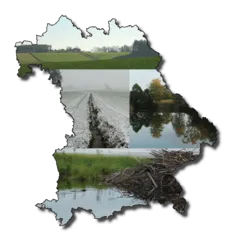ProNaHo
Process based modelling of natural and decentralized flooding retention measures to analyse the event and area-dependent efficiency (ProNaHo)

In 2001, the Bavarian government has determined an action program for sustainable flood protection (AP 2020), that performs measures throughout Bavaria in the three fields of action “natural support”, “technical flood protection” and “flood prevention” by 2020. After the flood in June 2013 it was expanded to the Action Plan on Floods2020plus. According to this, technical flood protection and natural retentions are closely linked.
While the physical efficiency in technical flood control structures can be calculated with the help of complex hydraulic models, the flood decreasing effect of natural and decentralized flood retention measures in the area is still controversial. The following research studies of ProNaHo are carried out in order to receive valid statements about the effectiveness of natural and decentralized flood retention measures:
Integration of measured data
Measured data is collected in dependency of land-usage and territory measurements and must be considered within the process-based modeling and multi-criteria calibration.
Variation of scale
The scale-dependent effectiveness of the measurements will be examined. The regional (<100 km²) but also the cross-regional effect (100 km² - 1000 km²) of the measurements has to be quantified by selecting suitable areas and an appropriate modeling strategy.
Specific inspection of measures in waters and floodplain
Regional and national restoration scenarios are considered, taking into account the variations of floodplain creation. Site-specific efficiency assessments, integral concepts of managed realignment, floodplain creation and water re-naturalization should be developed and examined in terms of their efficiency.
Sensitivity analysis
Appropriate areas are selected based on the variability of the site parameters such as topography, land-usage and soil properties. Sensitivity studies considering various precipitation-, flood events and the site parameters as: field gradient (parameter for restoration), planning area, specific volume (parameters for small retention), available area, past use (parameters for reforestation) and soil properties (parameters for management measures), will help to define thresholds for site-dependent efficiencies of measurements.
Funded by: Bayerisches Staatsministerium für Umwelt und Verbraucherschutz
Project start: 01.05.2015
Project end: 30.06.2020
Supervised by: Bayerisches Landesamt für Umwelt
Project management: Wolfgang Rieger / Sonja Teschemacher / Michael Neumayer
Projekt assistance: Sonja Teschemacher, Michael Neumayer, Fabian Merk, René Heinrich, Johanna Springer, Susanne Haas